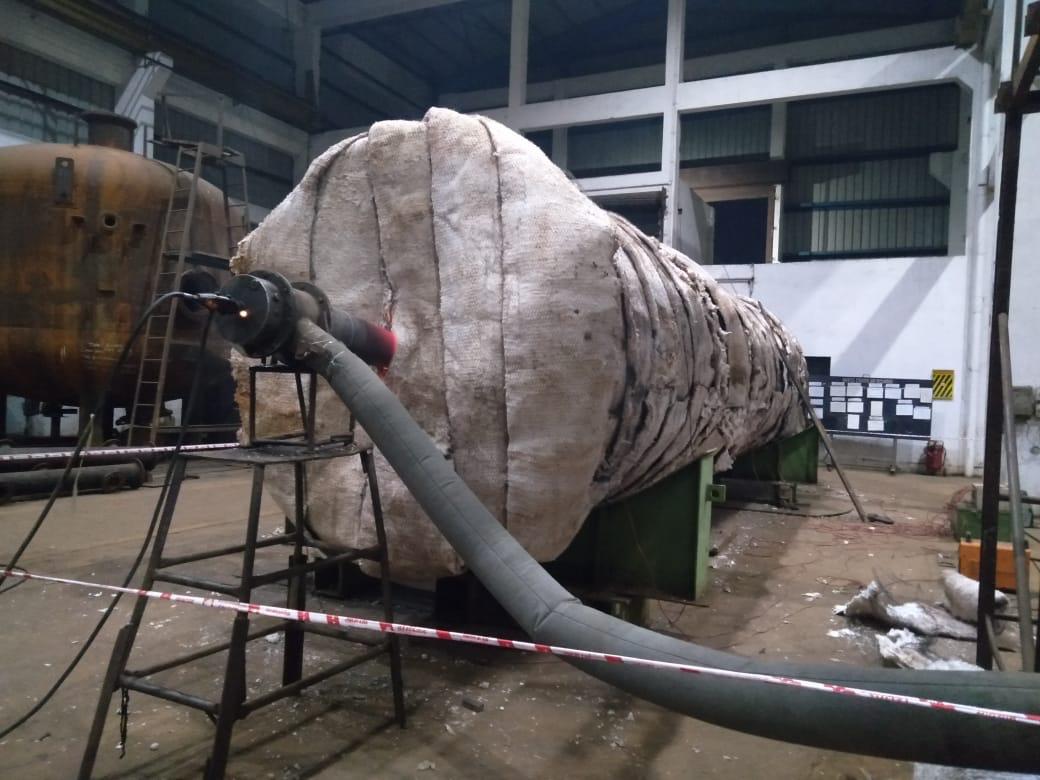
Post-weld heat treatment (PWHT) is a crucial process applied to welded components to enhance their mechanical properties and reduce residual stresses introduced during welding. Internal firing is one of the methods used to perform PWHT, particularly for hollow structures like pressure vessels and pipes.
What is Internal Firing?
Internal firing involves introducing a heat source inside the hollow component to raise its temperature to the required PWHT level. This is typically achieved using gas burners. The component itself becomes part of the furnace, with insulation applied to its exterior to retain heat and promote uniform temperature distribution.
Process Description
1. Preparation:
- The welded component (e.g., a pressure vessel) is positioned and supported.
- The exterior of the component is fully insulated with materials like ceramic fiber blankets to minimize heat loss.
- Burners are inserted into the component through مناسب openings (manways, nozzles).
- Thermocouples are attached to the component’s surface at various locations to monitor temperature distribution and control the heating process.
2. Heating:
- The burners are ignited, and the combustion process generates hot gases.
- High-velocity burners are often used to ensure good circulation of hot gases within the component, promoting temperature uniformity.
- The heating rate is carefully controlled to prevent excessive thermal gradients, which could lead to distortion or cracking.
3. Soaking:
- Once the component reaches the specified soak temperature, it is held at that temperature for a predetermined duration. This soaking period allows for stress relaxation and the desired metallurgical changes to occur.
4. Cooling:
- After the soaking period, the component is cooled at a controlled rate. Similar to the heating rate, the cooling rate is crucial for minimizing the development of new residual stresses.
Fuels Used in Internal Firing
The most common fuels used in internal firing are gaseous and liquid fuels, primarily:
- Natural Gas: This is a popular choice due to its clean burning properties, availability, and relatively low cost. It provides good temperature control and is suitable for a wide range of applications.
- Propane (LPG): Liquefied petroleum gas is another commonly used gaseous fuel. It is more easily transported and stored than natural gas, making it suitable for remote locations or temporary setups.
- Diesel Fuel: Diesel is a liquid fuel that can be used for internal firing, especially in situations where gaseous fuels are not readily available. However, it produces more emissions and requires careful handling and storage.
The choice of fuel depends on factors such as:
- Availability and Cost: The local availability and cost of each fuel type can vary significantly.
- Heating Requirements: The required heating rate and temperature may influence the choice of fuel.
- Environmental Regulations: Emissions regulations may restrict the use of certain fuels, such as diesel, in some areas.
- Equipment Compatibility: The burners and associated equipment must be compatible with the type of fuel used.
Applications
Internal firing is well-suited for PWHT of:
- Pressure vessels
- Pipes (especially large-diameter pipes)
- Boilers
- Storage tanks
- Other hollow structures with suitable openings
Advantages
- Efficient Heating of Hollow Structures: Provides direct heating of the interior, making it effective for large vessels and pipes.
- Relatively Cost-Effective: Can be more economical than building a temporary furnace around the component, especially for large structures.
- Good Temperature Uniformity: High-velocity burners and proper insulation can help achieve relatively uniform temperature distribution.
Disadvantages
- Limited to Hollow Structures: Not applicable to solid components.
- Potential for Hot Spots: Care must be taken to prevent flame impingement on the component’s surface, which can lead to localized overheating.
- Insulation Requirements: Effective external insulation is essential to minimize heat loss and ensure temperature uniformity.
- сложные Temperature Control: Requires careful monitoring and control of the heating process to avoid excessive thermal gradients.
- Not suitable for components with internals: Internals may hinder uniform heating.
Key Considerations
- Burner Placement and Design: Proper placement and design of burners are crucial for achieving uniform heating and preventing flame impingement.
- Fuel Selection and Management: The choice of fuel, its storage, and delivery system are critical for safe and efficient operation.
- Temperature Control: Accurate temperature measurement and control are essential. Multiple thermocouples and sophisticated control systems are typically used.
- Insulation: Effective insulation is vital to minimize heat loss, improve energy efficiency, and ensure temperature uniformity.
- Heating and Cooling Rates: Controlled heating and cooling rates are necessary to prevent distortion and cracking.
Component Support: Proper support of the component is required to accommodate thermal expansion and contraction during the PWHT process.
